Technical Excellence FLYING SPRAY Germany ROLLS ROYCE Clockwork Record Car 1939
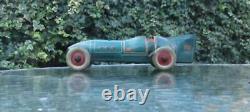
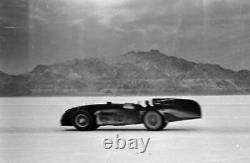
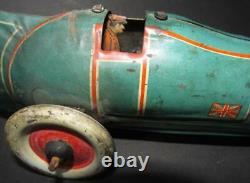
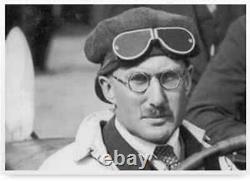
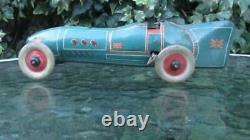
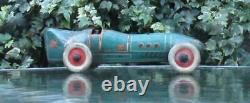
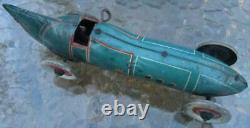
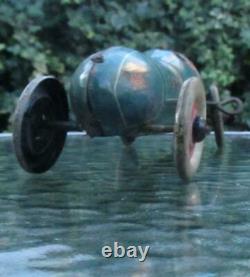
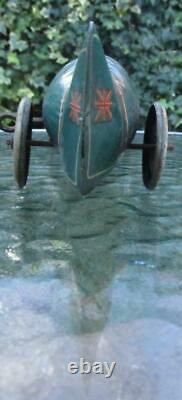
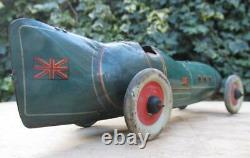
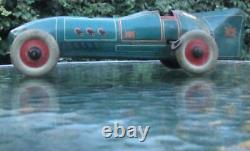
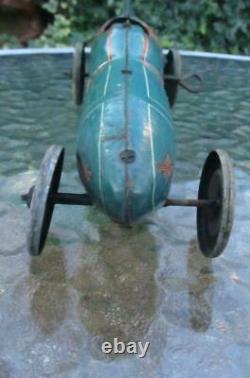

This is an especially interesting toy car as it was originally made in Germany - and simplistically modelled upon the Rolls Royce powered Speed Of Wind record car driven by George Eyston in 1937 to the land speed record at Bonneville Flats in the USA. However now a German company owns Rolls Royce. Interestingly the car was initially designed tapering down at the back but was modified for the 1937 record attempt so that the rear distinctively extended upward in a vertical tailplane in order to maintain directional stability and reduce drag. The car is simplistically modeled on this record car as shown - especially to be evocative in profile with the prominent distinctive rear wing added and helping to beat the record..
It was probably made by Gunthermann in Germany - the tin tabs and wheel spacer tube on and over one side of the front axle and glossy brightly lithographed blue paint were typical of Gunthermann. Not marked by the maker - presumably due to the unpopularity of Germany in Great Britain and America just before the war and of more spartan manufacture than previously produced Gunthermann record cars due to the severe financial depression in Germany at the time. The deep pressing of the tinplate to make the bulbous stern, produced crimping and folding of the metal, and was also typical of Gunthermann - especially seen in their tin figures. The driver is dressed in a flat cap - a manner associated with the press image of George Eyston during his racing career as shown.
I only know of this example in existence. The motor works to drive the wheels. Rolls Royce Clockwork Record Car 1938 Germany George Eyston Speed of Wind. Rolls Royce Clockwork Record Car 1939 Germany Speed of Wind / Flying Spray - Then bombed in 1940. This is an especially interesting toy car as it was originally made in Germany - and simplistically modelled upon the Rolls Royce powered'Speed Of The Wind' and'Flying Spray' record cars driven by George Eyston in 1937- 8 to the endurance land speed record at Bonneville Flats in the USA. Both Rolls Royce engines (Diesel and petrol) in the same body shell- under the names' Speed Of The Wind' and later'Flying Spray' helped establish the reliability and technical. Of Rolls Royce engines - especially in the USA.The car was secretly modified in the USA before its extended period of attempting and producing record runs by the addition of a tail-plane-like vertical fin. Return to the UK just prior to the outbreak of WW2 in 1939 was over-shadowed by the war and the car was placed in storage due to the outbreak of the war and was soon unfortunately destroyed by bombs.
In an interesting turn-around, now the German company BMW owns Rolls Royce cars. Also of Interest, the car was initially designed tapering down at the back (as shown below) but was modified for the 1937 record attempt and a subsequent career of record breaking attempts (especially endurance at speed) whilst it was in the USA so that the rear of the car distinctively extended upward in a vertical tail-plane in order to maintain directional stability and reduce drag. At the same time the entrance to the cockpit became characteristically'squared off' as seen in the present toy. Which was not in keeping with the aesthetics of the aerodynamics and so is a notable recognizable characteristic of the car. This toy car then, is simplistically modeled on this record car as shown - especially to be evocative in profile with the prominent distinctive rear wing added and helping to beat the record..
It was probably made by Gunthermann in Germany - the distinctive pattern of tin tabs - with clusters of 3 tabs in the tail section and locking washers over the tabs in the front section is also seen for example in Gunthermann's popular Felix the Cat toy and a wheel spacer tube on and over one side of the front axle and glossy brightly lithographed and detailed blue paint were both typical of Gunthermann in the 30s. Not marked by the maker - presumably due to the unpopularity of Germany in Great Britain and America just before the war and of more spartan manufacture than previously produced Gunthermann record cars due to the severe financial depression in Germany at the time and the limited information available about the car in its record breaking guise (with rear wing etc) upon its return from the USA. (Indeed not a lot is known about the car whilst it was in the USA) The deep pressing of the tinplate to make the bulbous stern and cab, - as can be seen - produced crimping and folding of the metal, and was also typical of Gunthermann - also especially seen and characteristic of their tin figures. The strong joining tabs were thus necessary due to the residual stresses and deformations of the deeply drawn halves of the toys Gunthermann produced. The driver is dressed in a flat cap - in a manner associated with the press image of George Eyston during his racing career as shown.The car, in its record -breaking winged configuration, did not get the public acclaim and world wide press coverage that Bluebird got because the press did not get to see it first hand before it was destroyed.. Thus there was not the opportunity for toy makers to get to examine and copy it - in the way in which it was configured for its record breaking runs in the USA. Few people saw it with its rear tail-plane - in the flesh - unlike Captain Campbell's Blue Bird and other strikingly designed record cars - which model and toy makers such as Gunthermann, Burnett and Kingsbury went to town in making models and toys of.
Hence the toy's rarity and simplicity of it's design. (Indeed the car was famous enough for Dinky to make a version of it - but such was the scarcity of detail about its record breaking runs that the Dinky toy totally lacked the distinctive winged tail) Highly probably then - the toy produced in the short period before the war in Germany for export to the UK (deduced from the fact that the Union Flag was also pretty unpopular in Germany in 1939 - although Germany still needed the income from this export business - and paradoxically more than ever during this period - in fact the war itself arising due to Germany being unable to pay off its debts) and based upon second hand observations of the car - with its wing modification. Explaining why there are few if any of this example in existence. Other similar German tin toys produced in 1939 are likewise rare for the same reason such as the Horndlein VW Kafer and a few of the Fleischmann boats.The tooling and market was lost in the war and in this case so was the real car upon which the toy was modeled. It does have a few spots of rust and play-wear. Obviously made - like a lot of Gunthermann tin toys - to be exported to Great Britain.
(NB There were probably other modifications - such as a cowl to reduce drag over the driver - which the real car used on some runs - which result in this model showing the driver to be totally enclosed - as he might have been in some record runs) (The Rolls Royce engine which powered Flying Spray escaped the blitz and is still on show at Beaulieu motor museum). Get Supersized Images & Free Image Hosting.
Create your brand with Auctiva's. Attention Sellers - Get Templates Image Hosting, Scheduling at Auctiva. The item "Technical Excellence FLYING SPRAY Germany ROLLS ROYCE Clockwork Record Car 1939" is in sale since Saturday, December 19, 2020.
This item is in the category "Toys & Games\Vintage & Classic Toys\Clockwork/Wind-Up". The seller is "greenergates" and is located in Stockport. This item can be shipped to North, South, or Latin America, all countries in Europe, all countries in continental Asia, Australia.- Country/Region of Manufacture: Germany
- Subtype: Clockwork/ Wind-Up
- Type: Vintage/ Classic Toys
- Vintage: Yes

